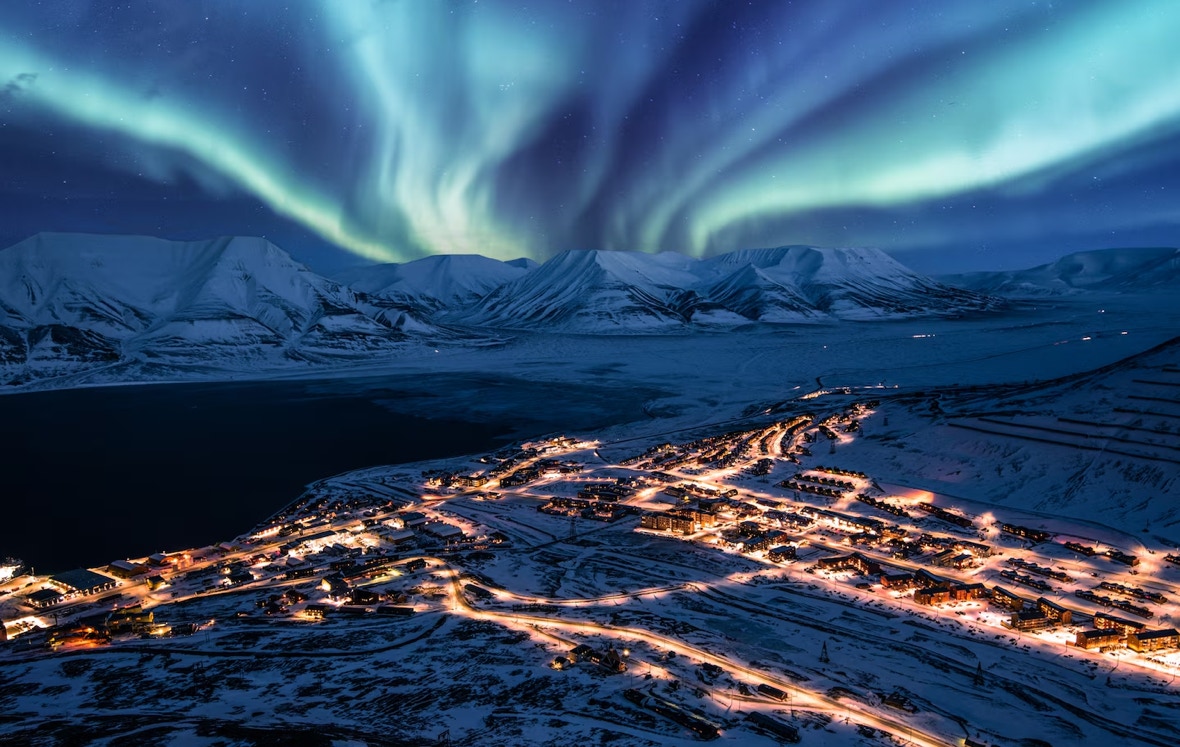





SCIENCE
How a rare, ‘once-in-20-years’ aurora formed at the North Pole
Scientists have identified the phenomenon as a polar rain aurora, never seen before from the ground.
A scenic view of snowcapped mountains illuminated by ribbons of aurora. City lights flow like ribbons from below the mountains.
On December 25 and 26, 2022, researchers documented a rare polar rain aurora from Longyearbyen, Norway, seen above beneath the more common aurora borealis. Polar rain auroras form via a different mechanism than a typical aurora and are extremely hard to observe.
PHOTOGRAPH BY FREDRIK MELING, 500PX/GETTY IMAGES
ByIsabel Swafford
June 21, 2024
In the wee hours one Christmas morning on the arctic island of Svalbard, Norway, a fisheye lens pointed up at a bright green night sky. Unlike the iconic aurora borealis, where thin, snake-like structures weave beneath constellations, this aurora diffused across the sky in an almost uniform blanket of green.
“This aurora [was] very smooth in shape, and the structure is just a diffuse patch of greenish stuff. It [was] like a big greenish cake,” says Keisuke Hosokawa, a space physicist at the University of Electro-Communications in Tokyo, Japan. Hosokawa had never seen anything like it.
The strange aurora covered the North Pole sky on December 25 and 26, 2022, and Hosokawa and his colleagues have now identified the phenomenon as a rare polar rain aurora in Science Advances.
Rain at the North Pole
Auroras are a product of electrons from the sun that get trapped and accelerated by Earth’s magnetic field. The electrons flow out from the sun’s corona, its outermost atmosphere, in plasma called solar wind.
Due to the solar wind’s wide variety of high-energy particles, solar wind electrons typically do not have enough energy to create visible auroras upon arriving at Earth. But once they get trapped by the planet’s magnetic field and excited, the electrons interact with the atoms in our atmosphere and produce auroras. The light shows appear around Earth’s poles, but rarely over the polar caps themselves.
An all-sky camera in Longyearbyen, Norway, captured these images of a polar rain aurora blanketing the sky in green above the North Pole.
PHOTGRAPHS COURTESY KEISUKE HOSOKAWA, ET AL., 2024
In contrast, polar rain auroras are caused directly by solar wind electrons, during rare instances of little to no solar wind. The newly described event from 2022 “is a fascinating counterexample in which one polar cap appears to be filled with electrons arriving directly from the solar corona,” says David Knudsen, a physicist at the University of Calgary, in Canada, not involved in the study. “This is a highly unusual occurrence.”
Polar rain auroras have been caught in satellite data before, but never from ground cameras on Earth. Hosokawa happened upon the 2022 aurora by accident, after taking a break during the holidays from his weekly routine of checking aurora cameras. When he was casually reviewing the backlog of data, he discovered the aurora like a belated Christmas present.
“When I saw that kind of strange aurora, I suddenly realized this is special, and I needed to do something. So, I started looking at the satellite data obtained at the same time, and I saw the polar rain signature,” says Hosokawa.
(Learn more about the science of the northern lights.)
A day without solar wind
Not only is the aurora a direct result of relatively weak electrons traveling straight from the sun, but it is also a rare example of a period of 28 hours with almost no solar wind, save for the polar rain electrons.
Solar wind is constantly flowing out into the solar system from the sun’s corona, so it is very unusual to see it all but disappear. “A once-in-20-years” type of experience, Hosokawa calls it, referencing the only other record of a polar rain aurora in 2004, which was only observed from space.
The lack of solar wind made Hosokawa’s polar rain aurora exceptionally bright and, thus, easier to see from the ground. The dual observations from the ground and space are essential to understanding both the fine details and large-scale patterns of the aurora.
Since the electrons precipitating the polar rain aurora are coming directly from the sun, they act like a shadow or imprint of the environment they came from. Hosokawa and his colleagues hope to use this data to understand the relationship between the electrons arriving on Earth and where they came from in the sun’s atmosphere.
“The really exciting aspect of this paper is that it shows that there are still fundamental discoveries to be made,” says Larry Paxton, coauthor and astrophysicist at John Hopkins Applied Physics Laboratory in Baltimore, Maryland. “We now have a system of satellites and ground-based observatories that allow us to see, for the very first time, a new way that our sun is connected to the Earth.”
